FBI memos show Bureau disregarding videotape of Mel Phillips sexually assaulting a ring boy
How the '90s DOJ inquiry into WWE shifted from child sexual abuse to steroid distribution is murky, but newly unredacted FBI memos give us a hint as to where it went wrong.
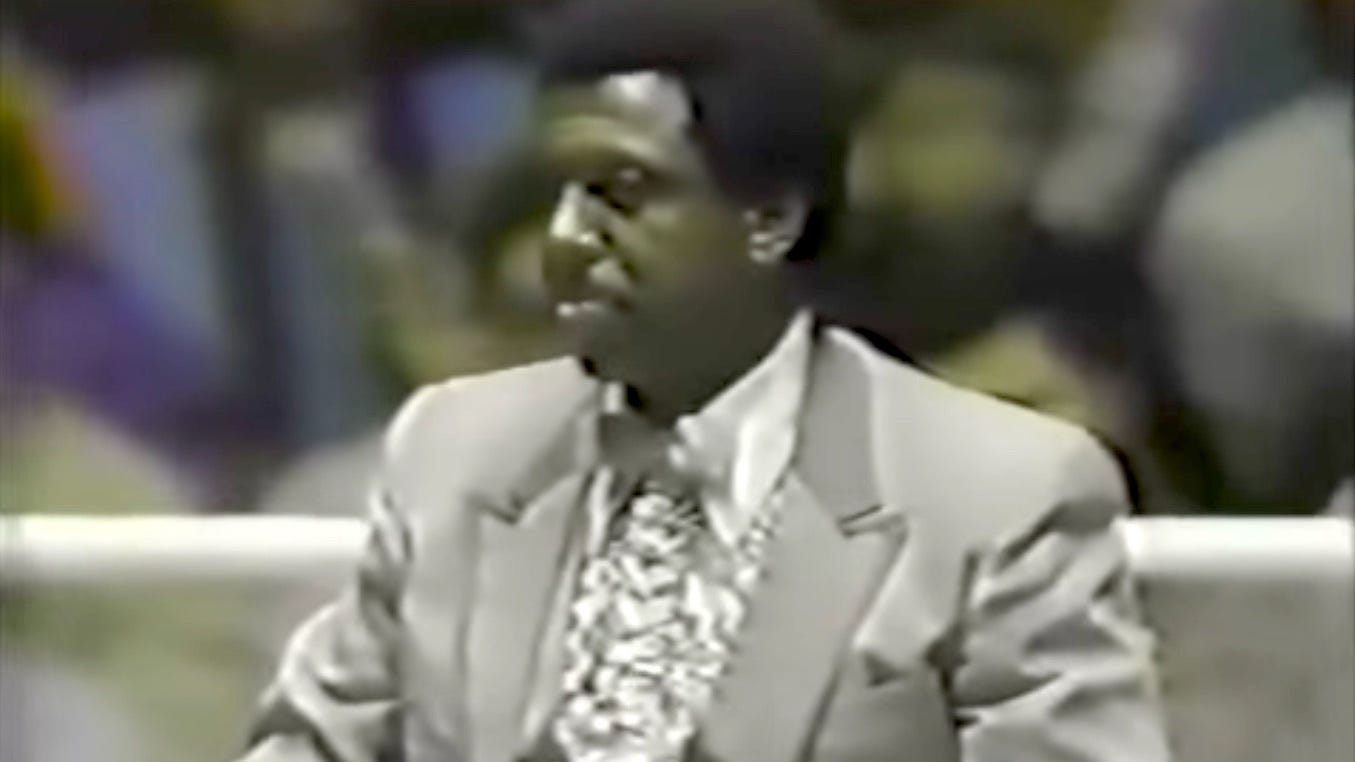
Content warning: This article, by necessity, contains descriptions of child sexual abuse and law enforcement inaction in a subsequent investigation of those allegations. If you believe that you may find such descriptions triggering other otherwise upsetting, then you should proceed only with the utmost caution. If you feel the need to talk someone, then visit RAINN.org for information on their 24/7 National Sexual Assault Hotline, which includes telephone and web-based chat options.
There’s a common misconception about the nature of the federal investigation of Titan Sports (d/b/a the WWF)—now WWE—that led to Vince McMahon’s criminal trial on conspiracy and steroid distribution charges in July 1994. If you asked the average longtime hardcore fan how it came about, they’d likely say it was a byproduct of Dr. George T. Zahorian III’s conviction for distributing anabolic steroids for non-medical use while working for the Pennsylvania State Athletic Commission. In actuality, the grand jury was impaneled in the immediate aftermath of Phil Mushnick’s New York Post columns from early 1992 about the sexual abuse of "ring boys," the mostly underage boys who helped with ring assembly and other grunt work. When Mushnick called for a federal investigation of Titan and investigator Anthony Valenti of the federal prosecutor’s office in the Eastern District of New York phoned him the next day, the topic was child sexual abuse. A grand jury was impaneled within days, though the news of its existence wouldn’t break until Alex Marvez pinned down the story in the July 15, 1992 edition of the Miami Herald. The short item penned by the future AEW announcer specified that “allegations of sexual abuse of minors and the illegal transportation of minors across state lines” were the focus of the investigation.
How that focus shifted, though, has always been a bit of a mystery, especially in light of what charges the feds eventually tried to pursue. What was, on paper, the Department of Justice’s strongest count against Vince McMahon—for distributing steroids to Hulk Hogan as opposed to more nebulous charges of conspiring with Zahorian—fell apart in embarrassing fashion on the sixth day of trial testimony. Emily Feinberg, McMahon’s former personal assistant turned paramour, testified about a package of steroids that he received on October 24, 1989, only to split the contents with Hogan by having his driver, Jim Stuart, courier them to the Nassau Coliseum. The problem with this scenario was that the closest date where the WWF ran a the Nassau Coliseum was October 20. The prosecution had missed the obvious discrepancy the whole time.
Now, in 2021, newly unredacted FBI memos from the investigation into what’s now WWE give further insight into how badly the feds bungled the case. In an echo of the recent Inspector General report on the FBI’s mishandling of the crimes of USA Gymnastics physician/serial child molester Dr. Larry Nassar, the Bureau did not seem to take the sexual abuse allegations against ring announcer/ring crew chief Mel Phillips very seriously. Specifically, not only did the FBI admit that they were seeking Phillips’ cooperation against McMahon, but they also disregarded a videotape that showed Phillips, who died in 2012, doing exactly what multiple victims accused him of doing.
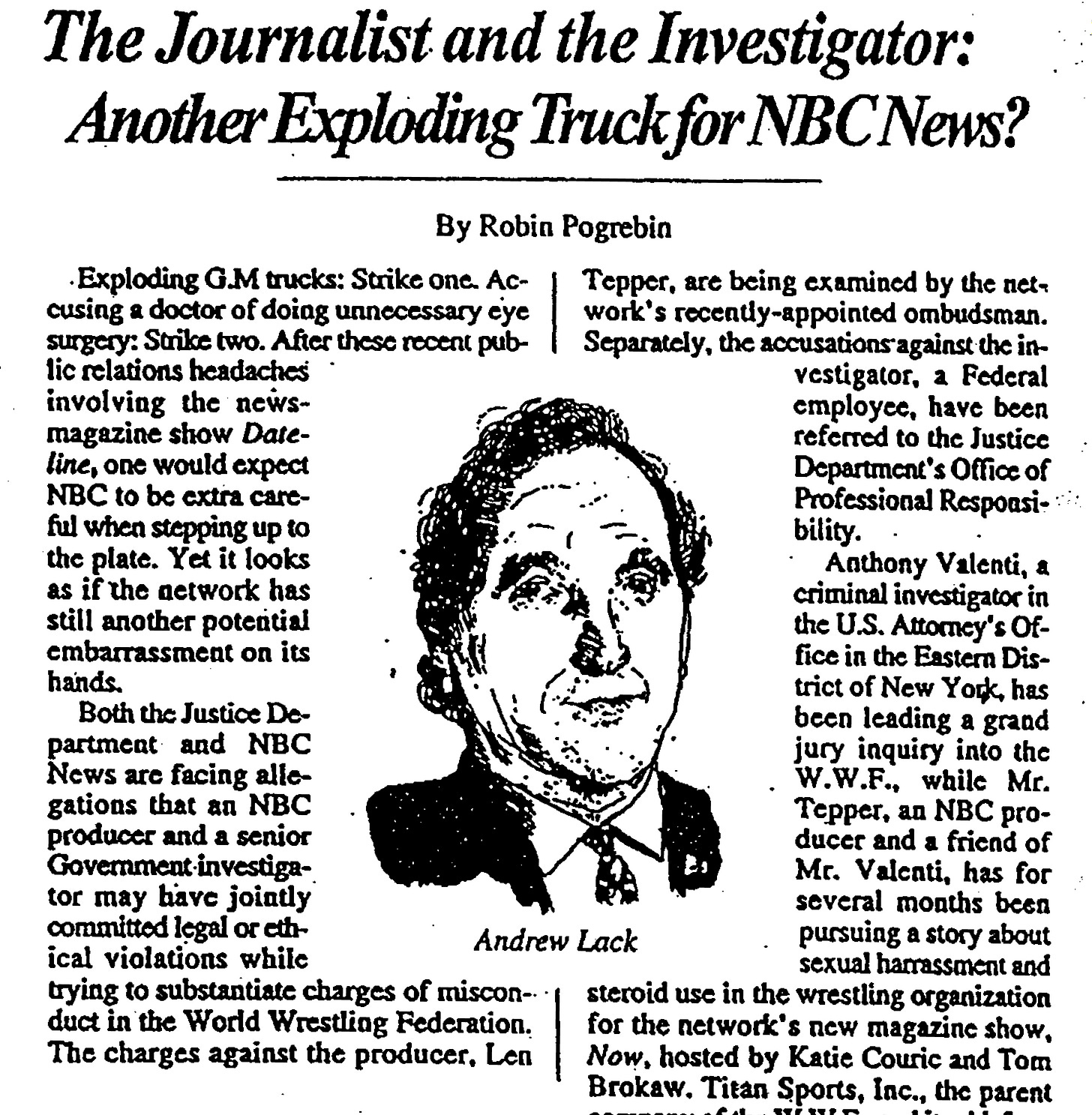
That there was a potentially incriminating videotape of Phillips in the possession of investigators was not a secret, but it’s not something that’s remotely well-known. Its existence was first revealed publicly in a story that merited front page status in the September 13, 1993 issue—it hit newsstands on September 8—of the New York Observer, an influential weekly broadsheet that’s widely considered one of the inspirations for the editorial voice of Gawker.com. Written by Robin Pogrebin, now at the New York Times, the piece centers on the allegation that Anthony Valenti and NBC News producer Len Tepper “may have jointly committed legal or ethical violations” while the latter was working on a feature about the ring boy abuse scandal. (It was earmarked for the newly-launched Now with Tom Brokaw and Katie Couric, which eventually morphed into Dateline Wednesday.) On the page, the story reads as slanted towards Titan, if just because the topic at hand is repeatedly compared to the disastrous, fabricated Dateline feature about exploding GM trucks that had aired 10 months earlier.
“[Tepper] spent hours on the telephone attempting to obtain a videotape that he suspected showed Mr. Phillips. the former ring announcer, cavorting with some ringboys,” wrote Pogrebin. “The tape belonged to John Maloof, a former W.W.F. employee who eventually agreed to send it to NBC, having been convinced by Mr. Tepper that airing it would help bring Mr. Phillips the discipline he deserved.” Maloof, however, would get cold feet, telling Pogrebin he felt that Tepper’s goal had gone beyond nailing Phillips because “he's got this hatred it seems like, for Vince McMahon.” He stopped the Federal Express shipment of the tape, and claimed that Tepper repeatedly engaged in “beggin,” “yelling,” and “pleading” for the tape in subsequent phone calls. Pogrebin, without citing the allegation, then added that “Tepper allegedly advised the shipping clerk for Federal Express that Government agents would be called in to get the package,” with Valenti showing up hours later.
Days later, in the issue of the Wrestling Observer Newsletter cover dated September 20, Dave Meltzer wrote that Pogrebin’s article in the other Observer was “believed to have been the product of a public relations agency working for Titan Sports.” He added that the story was aggregated with blurbs in both the New York Daily News and USA Today, referring to the latter as“a newspaper that for years has come under heavy criticism for its seemingly biased coverage whenever issues involving Titan Sports have come to light.” Both blurbs focused on the WWF alleging collusion between Tepper and Valenti while also carrying strong denials from NBC spokeswoman Beth Comstock. Though Meltzer felt that the WWF’s public relations efforts had failed, Tepper’s ring boys segment would never see the light of day.
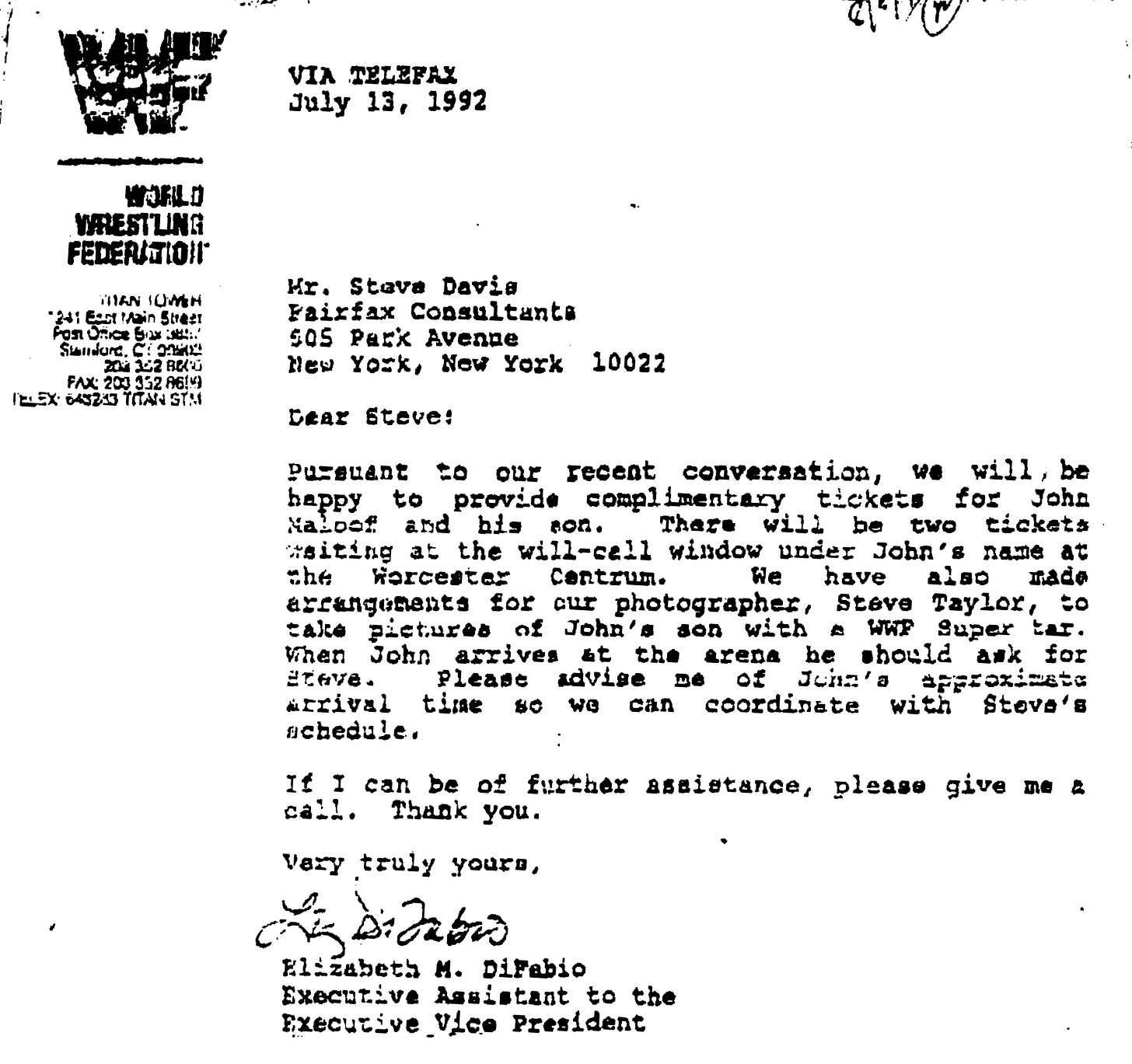
Documents obtained by Mushnick and the Post in discovery would show that Maloof had sent a copy of the tape to Titan’s private investigators at Fairfax Consultants (later renamed DSFX) at some point in 1992 in exchange for autographs for his son. This just further suggested that the video was of particular interest. Over two years later, in November and December 1995 in the New York Post (by Mushnick and Jack Newfield) and The Village Voice (an in-depth feature by William Bastone), it would be reported that Pogrebin’s Observer story was planted by Marty Bergman, the brother of legendary 60 Minutes producer Lowell Bergman and secret fiancee of McMahon defense lawyer Laura Brevetti. Though full of redactions of the names of living persons, among other things, Bergman’s own FBI file, which I also obtained under the Freedom of Information Act, appears to line up pretty closely with the 1995 reporting, especially Bastone’s.
(That Bergman FBI file also includes the revelation that a different grand jury was impaneled to investigate the allegations that he obstructed justice with regards to the McMahon trial; the Bureau’s investigation lasted well into 1998 before being closed. The FBI did not, however, release the 51 page Declination of Prosecution Memorandum explaining why the case was closed without further action.)
For Titan’s part, attorney Jerry McDevitt gave their side of the Maloof affair in a sworn affidavit accompanying a pleading in the Mushnick lawsuit where he attempted to block a motion to compel production of the tape. “When Mr. Mushnick originally generated the stories about pedophilia, Mr. Maloof contacted Titan to indicate that he knew Mr. Phillips and expressed the view that Mr. Phillips had never done anything wrong to him or in his presence,” he wrote. (McDevitt’s description of the tape was that it “depicts Mr. Mel Phillips in a wrestling ring with several younger males.”) The rest largely lines up with Pogrebin’s New York Observer story, with McDevitt also adding that:
“At all times relevant hereto, Mr. Maloof was unequivocal in expressing his desire that Tepper not be given acopy of the videotape in question.”
“My concern then and now is that Mr. Mushnick would have made a copy of the tape and provided it to Mr. Tepper, against Mr. Maloof's desires and in order to further harm my clients.”
What exactly was on the tape, then? As I reported last year at Business Insider, a memo in the version of the WWF’s FBI file that I had at the time indicated that the videotape being shot in a public place—the ring before a WWF show—and “contain[ing] no obvious sexual activity” allowed for “too many alternate explanations” from Phillips. That memo was heavily redacted, though, so I filed a new Freedom of Information Act request asking for the reprocessing of it and all other memos that appeared to reference the child sexual abuse side of the federal investigation. That request paid off, just not necessarily in the ways I expected.
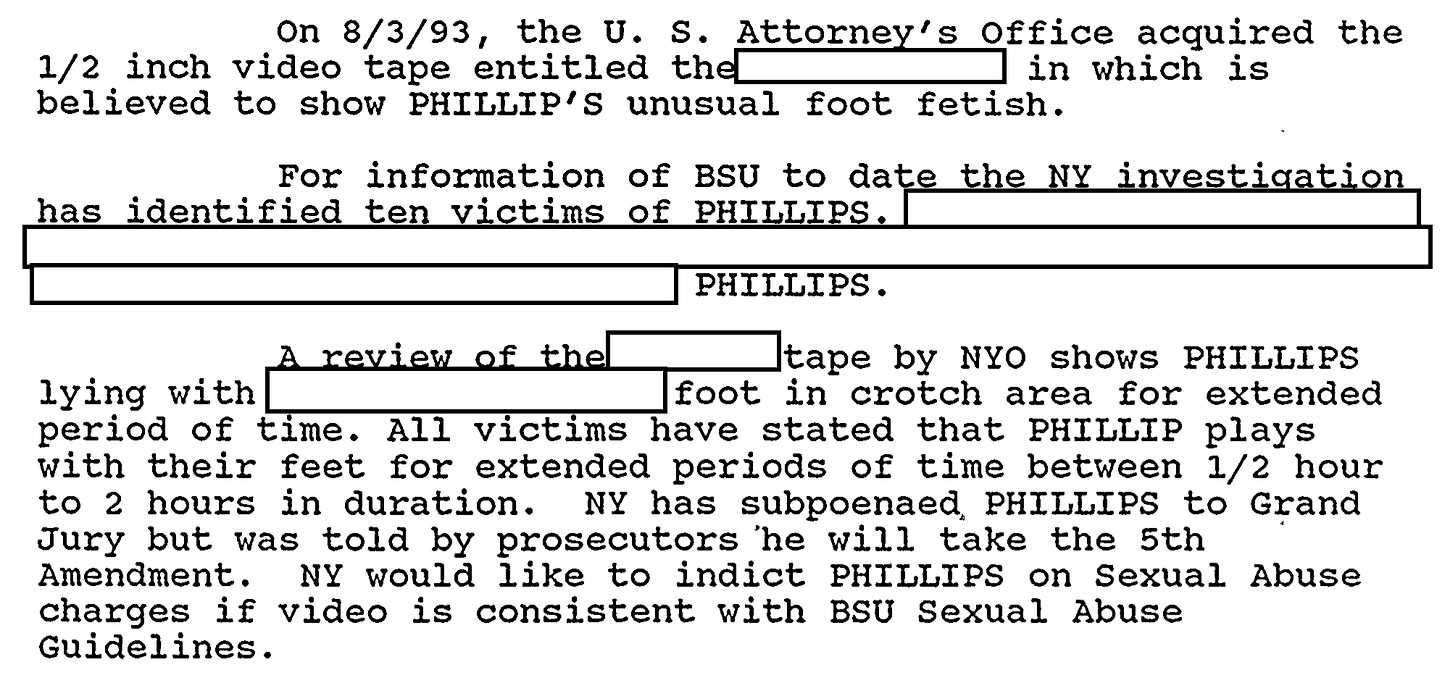
“A review of the [redacted] tape by NYO shows PHILLIPS lying with [redacted] foot in crotch area for extended period of time,” reads the September 30, 1993 memo accompanying the Maloof tape to the FBI’s Behavioral Science Unit. “All victims have stated that PHILLIP [sic] plays with their feet for extended periods of time between 1/2 hour to 2 hours in duration. NY has subpoenaed PHILLIPS to Grand Jury but was told by prosecutors he will take the 5th Amendment. NY would like to indict PHILLIPS on Sexual Abuse charges if video is consistent with BSU Sexual Abuse Guidelines.”
That gives a much different impression than the versions of the relevant memos that were previously available, if just because what’s described lines up exactly with how multiple victims described their abuse at Phillips’ hands. Tom Cole’s complaint against Titan, for example, which was accompanied by a sworn Cole affidavit attesting to its honesty, alleged that Phillips "would frequently caress plaintiff's feet and would rub them against [Phillips'] own genital area." As I reported last year in the Business Insider feature, another ring boy told Cole’s lawyer in 1992 that “when [Phillips] was wrestling with us…grabbing our toes, he would put us in between his legs up near his groin area.” In 2016, HuffPost reported that another ring boy had sued the WWF and Phillips over similar abuse in 1999; his complaint alleged that “Mel Phillips would often take [Plaintiff] aside and play a ‘game’ with him” where “Phillips would then rub Plaintiff’s feet and toes against his crotch and would pull Plaintiff’s toes apart until Plaintiff screamed.” In other words, this appeared to be part of the ring announcer’s modus operandi. (In addition, the same FBI memo notes that “the NY investigation has identified ten victims of PHILLIPS.” about twice as many as had gone public.)
The memos don’t state whether or not the FBI knew that what the tape showed was exactly what Phillips was being accused of. But it was also far from a secret that this was what was being alleged, and Cole had testified before the grand jury several times by then. Though his previously un-filed complaint would not become public record until filed by Titan as an exhibit in December 1993, the scrutiny of the Maloof tape occurred before Cole became reluctant to share the full details of his abuse in interviews. More specifically, he gave those explicit details in a February 1994 New York Daily News article. (Regardless, it would seem to strain credulity to suggest that the grand jury didn’t subpoena obtain the relevant documents from Cole, Mushnick, or Titan.)
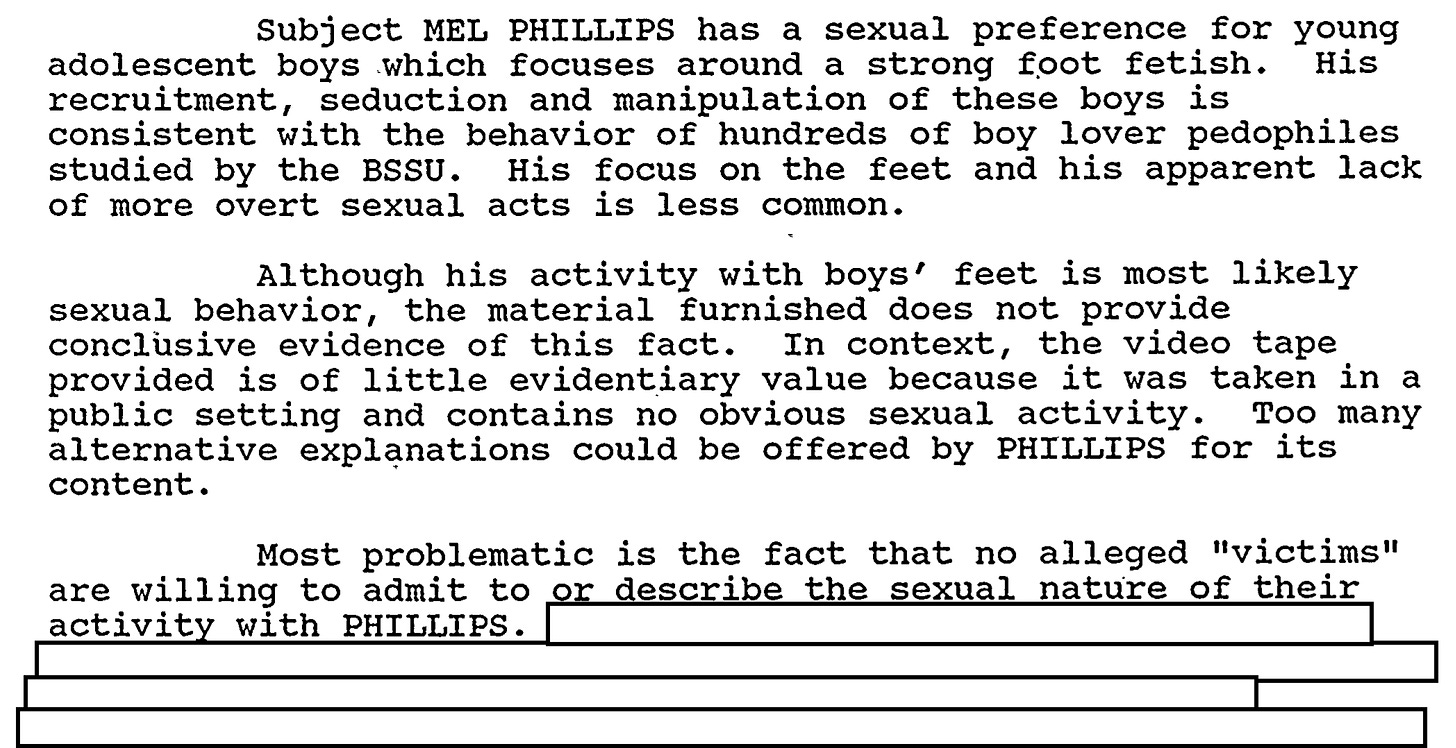
This is all complicated by the reprocessed version of the memo that contains the Behavioral Science Unit’s assessment of the Maloof tape. Most curiously, it doesn’t at all acknowledge anything that the previous memo said about what the tape showed Phillips doing, much less that it fit his known M.O. It also reads terribly in general in 2021, noting that “Most problematic is the fact that no alleged ‘victims’ are willing to admit to or describe the sexual nature of their activity with PHILLIPS.” (As of this writing, the FBI’s press office has not responded to an email requesting comment on the handling of the Maloof tape.)
The implication of the line about “alleged ‘victims’” is seemingly that none of the ten victims who the FBI interviewed had accused Phillips of anything beyond playing with their feet. Anything along those lines, intentional or otherwise, has the ring of WWE’s attempted reframing of what happened much more than it does what you’d expect from law enforcement officers investigating child sexual abuse. “Cole claimed Mel Phillips had a foot fetish and played with his feet,” WWE attorney Jerry McDevitt wrote to myself and various representatives of Business Insider last year, contrasting such behavior with “anything approximating conventional forms of sexual abuse such as rape, sodomy, etc.” (As noted earlier, Cole’s complaint sent to Titan on March 13, 1992 was explicit in detailing that Phillips did much more than “play with his feet,” as was his New York Daily News interview published 23 months later on February 13, 1994.)
Complicating matters even further? A January 27, 1993 memo, also newly reprocessed, made it clear that the FBI’s intent in trying to deal with Phillips was to compel him to testify against McMahon and Titan. “New York hopes to surprise Phillips at his residence and obtain his cooperation in the investigation without WWF attorney involvement,” it reads. (When they went to Phillips’ home to serve his subpoena a week later, he wasn’t there.) Even though Phillips was, in theory, a target of the investigation, the memos, in their totality, suggest that the plan was to charge him solely to get him to take a deal and turn on McMahon.



In addition, as I was working on this story, I received the response to my FOIA request about Phillips that I had filed with the Executive Office of the U.S. Attorney in 2017. Despite Phillips, again, seemingly being a target of the investigation—and the FBI records’ suggestion that the U.S. Attorney’s office was leading the child abuse side of the probe, not the Bureau—they claimed to have just 84 pages about Phillips, with only 35 being releasable.
Those 35 pages were a transcript of the Larry King Live episode about the 1992 scandals, just with all of the notes that someone wrote in the margins having been redacted. (For comparison, a separate FOIA request to the EOUSA, about Jim Stuart, Vince McMahon’s former driver, yielded 246 pages—out of 282 found—consisting of mundane internal Titan Sports errata and records from Stuart’s lawsuit against the company.) Though it could just be garden variety FOIA obstruction, it doesn’t exactly help the perception that the DOJ punted on the child sexual abuse side of their investigations into the future WWE.
We may very well never know the full extent of where the investigation into Mel Phillips went wrong. In light of the now more complete memos about John Maloof’s videotape, though, we can say that crucial, seemingly “smoking gun” evidence was ignored, albeit with the reason for that remaining murky. Even the most charitable read, though, suggests that those working on the case didn’t see what was repeatedly described by Phillips’ victims as sexual abuse as actually being sexual abuse.
Here’s to hoping that we’ve at least gotten past that kind of thinking.

